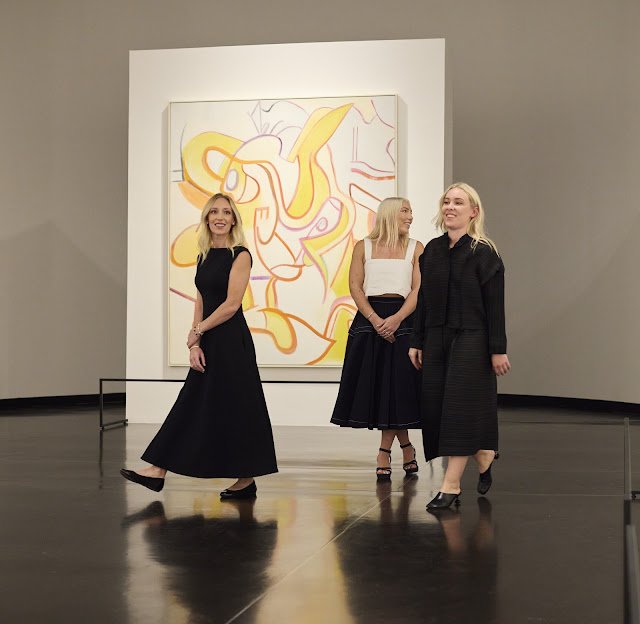Biennale Arte 2024 - Giardini - National Pavilions
Germany Pavilion
Yael Bartana - Ersan Mondtag - Thresholds
Under the title Thresholds, the Germany Pavilion explores history and the future in three scenarios: In the first scenario, artist, photographer, and filmmaker Yael Bartana departs from a present perceived as catastrophic; a world on the brink of total destruction. In the second scenario, the theatre and opera director Ersan Mondtag develops a space that contrasts the monumental character of the pavilion with a fragmentary, seemingly minor narrative. In a third scenario, the contribution engages in building a bridge to another location outside the Giardini: the island of La Certosa. Here the artists Michael Akstaller, Nicole L’Huillier, Robert Lippok, and Jan St. Werner create a resonant space with works that focus on the significance of the moment of temporal and spatial transition.
vanishing past and an unclear future."
"For those affected by migration, however, it is a fundamental three-dimensional and bodily experience, because the current state of migration is always one of living at the intersection of different belongings. This is where the historiographical and, thus, political difference from the dominant societies’ primarily territorial or national perspectives lies. "
Germany Pavilion
Great Britain Pavilion
John Akomfrah - Listening All Night to the Rain
In the Great Britain Pavilion, John Akomfrah, an artist and filmmaker, explores memory, racial injustice, migrant diasporas, and climate change. His exhibition, Listening All Night To The Rain, delves into post-colonialism, ecology, and the politics of aesthetics with a focus on listening as activism. It features a single installation with eight multi-screen sound and time-based works, using bodies of water as a central motif to connect layered visual and sonic narratives. Reflecting Akomfrah's interest in non-linear storytelling, the exhibition examines how vast historical narratives across five continents resonate with the experiences of diasporic people in Britain.
John Akomfrah
artist and filmmaker
"Bodies of water are a central motif in Akomfrah’s exhibition and form a connective tissue that holds the many layered visual and sonic narratives together. Together with the sonic, Akomfrah explores the role of water in understanding our world and holding memory."
"The exhibition is seen as a manifesto that encourages the idea of listening as activism and is conceived as a single installation with eight interlocking and overlapping multi-screen sound and time-based works."
Great Britain Pavilion
John Akomfrah - Listening All Night to the Rain
Yuko Mohri - Compose
Known for installations and sculptures that change with environmental conditions, Yuko Mohri's exhibition, curated by Sook-Kyung Lee, fills the Japan Pavilion with sound, light, movement, and smell. Inspired by Tokyo subway efforts to stop water leaks, Moré Moré - Leaky - artificially creates leaks and fixes them using household goods from Venice, addressing global flooding issues, particularly relevant to flood-prone Venice. The exhibition also features decomposition, where electrodes in fruits generate sound and light, modulating as the fruits decay and emit a sweet smell. Titled to signify "to place together," it explores the meaning of collaboration amid global crises, highlighting creativity in crisis-inspired resourcefulness.
"Inspired by ad hoc efforts seen in Tokyo subway stations to stop water leaks, Moré Moré - Leaky - artificially creates leaks and then attempts to fix them, improvising with a variety of household goods available in Venice to construct kinetic sculpture. In a world where floods affect the environment, and especially in Venice, a city hit by a flood once every fifty years, the last one in 2019, Moré Moré resonates with a wide range of issues."
artist
Japan Pavilion
Yuko Mohri - Compose
Julien Creuzet - Attila cataract your source at the feet of the green peaks will end up in the great sea blue abyss we drowned in the tidal tears of the moon
The matoutou falaise, found in dense forests, on Zamana trees, or Martinique's rocks, symbolizes a deep connection to the environment, focusing on appearances, disappearances, and the unseen. Julien Creuzet aims in the France Pavilion to immerse viewers in a poetic experience of forms, sounds, and colors, creating new languages. This tarantula, endemic to Martinique, embodies a way of engaging with art that nourishes and protects, teaching a poetic understanding of the world and offering a gentler approach to life's ecologies. Creuzet’s work represents emancipation, inviting us to learn, unlearn, and reconcile with our senses in a liberated space.
"Creuzet’s forms stem from a locus of emancipation, which must be felt to truly see. It is a moment of learning and unlearning as a reconciliation with our senses, as well as a space to be untranslated and liberated."
volumes and lines in movement,
colourful encounters forming new languages:
an experience to be lived deeply."
France Pavilion
Julien Creuzet - Attila cataract your source at the feet of the green peaks will end up in the great sea blue abyss we drowned in the tidal tears of the moon
Sandra Gamarra Heshiki - Migrant Art Gallery
In the Spain Pavilion Sandra Gamarra Heshiki's new works, based on paintings from Spanish art collections, explore the absence of decolonial narratives in museums. Her research reveals biased representations of colonizers and the colonized, intertwining sociology, politics, art history, and biology. This reinterpretation connects historical consequences to present-day issues of racism, migration, and extractivism, addressing both ecological and museological crises.
"Sandra Gamarra Heshiki’s extensive research is manifested in new works based on paintings that belong to the national heritage of Spanish art collections from colonial times to the Enlightenment."
Spain Pavilion
Sandra Gamarra Heshiki - Migrant Art Gallery
Visit
Biennale Arte 2024



























































